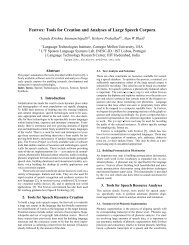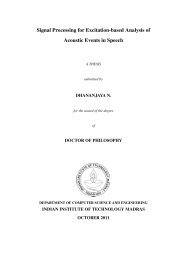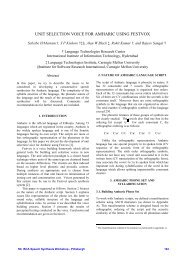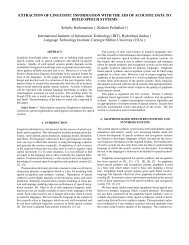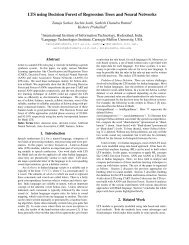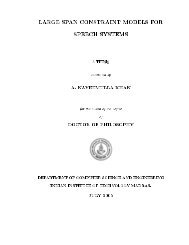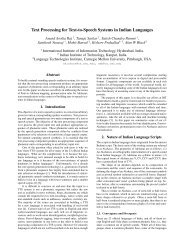word boundary- hypothesisation in hindi speech - Speech and ...
word boundary- hypothesisation in hindi speech - Speech and ...
word boundary- hypothesisation in hindi speech - Speech and ...
You also want an ePaper? Increase the reach of your titles
YUMPU automatically turns print PDFs into web optimized ePapers that Google loves.
detected <strong>in</strong> a H<strong>in</strong>di text. The results show that longer sequences detect more <strong>word</strong><br />
boundaries but they are also more error prone. Moreover, use of long sequences also<br />
<strong>in</strong>creases the uncerta<strong>in</strong>ty <strong>in</strong> the actual location of the <strong>word</strong> <strong>boundary</strong>. Hence, <strong>in</strong><br />
practice, this may not result <strong>in</strong> any significant improvement <strong>in</strong> lexical analysis, when<br />
compared to the shorter sequences.<br />
In the <strong>speech</strong> context, the lexical clues are to be applied on a symbol str<strong>in</strong>g<br />
which may conta<strong>in</strong> errors. Tests were conducted us<strong>in</strong>g sentences <strong>in</strong> which <strong>speech</strong>-like<br />
errors were simulated, <strong>and</strong> the performance of the lexical clues was estimated. The<br />
results show that the lexical clues are useful even for large percentage errors <strong>in</strong> the<br />
<strong>in</strong>put symbol str<strong>in</strong>g.<br />
In addition to the language <strong>and</strong> lexical clues, one can also exploit prosodic <strong>and</strong><br />
acoustic-phonetic knowledge sources. In the study on the identification of prosodic<br />
clues for <strong>word</strong> <strong>boundary</strong> <strong>hypothesisation</strong>, four prosodic features of pause, duration,<br />
amplitude <strong>and</strong> pitch were considered. Of these, pauses are the simplest <strong>and</strong> most<br />
reliable clues to <strong>word</strong> boundaries. In our study, it was found that pauses can be used to<br />
detect only a few <strong>word</strong> boundaries, less than 20% of the total boundaries. It was also<br />
found that a simple strategy of hypothesis<strong>in</strong>g a <strong>word</strong> <strong>boundary</strong> after every long vowel<br />
results <strong>in</strong> the detection of many <strong>word</strong> boundaries (more than 70%) with errors less<br />
than 25%. Pitch changes were also found useful to hypothesise <strong>word</strong> boundaries. In our<br />
study, it was found that a drop <strong>in</strong> FO can be used to hypothesise a <strong>word</strong> <strong>boundary</strong>. This<br />
detected more than 70% of the <strong>word</strong> boundaries with errors less than 30%. A<br />
comb<strong>in</strong>ation of pause, duration <strong>and</strong> pitch resulted <strong>in</strong> the detection of more than 75%<br />
of the <strong>word</strong> boundaries with errors less than 15%.<br />
In the study on the identification of acoustic-phonetic clues, two simple clues,<br />
based on changes <strong>in</strong> the first formant were considered. The first clue uses changes <strong>in</strong>





